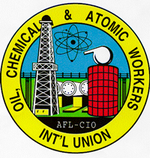- Oil, Chemical and Atomic Workers International Union
-
OCAW 
Full name Oil, Chemical and Atomic Workers International Union Founded 1918 Date dissolved January 4, 1999 Merged into Paper, Allied-Industrial, Chemical and Energy Workers International Union Members 80,000[1] Country United States Affiliation American Federation of Labor (1918-1955)
AFL-CIO (1955-merger)The Oil, Chemical and Atomic Workers Union (OCAW) was a trade union in the United States. At the time of its dissolution and merger in 1999, the International represented 80,000 workers and was affiliated with the AFL-CIO.
The union was founded as the International Association of Oil Field, Gas Well, and Refinery Workers of America in 1918 after a major strike in the Texas oil fields in late 1917.[2] It affiliated with the American Federation of Labor (AFL). Its membership grew to 30,000 as the oil industry grew rapidly in the United States, but the Great Depression reduced its ranks to just 300 in 1933. In 1937, the union changed its name to the Oil Workers International Union (OWIU). The union affiliated with the Committee for Industrial Organization in early 1938, and AFL President William Green revoked the union's AFL charter. The OWIU extended its membership into Canada in 1948.[3][4]
OWIU and the United Gas, Coke, and Chemical Workers' Union (UGCCWU) merged in February 1955 to form the Oil, Chemical, and Atomic Workers Union (OCAW). The UGCCWU had broken away from the United Mine Workers of America in 1942, and won a charter from the Congress of Industrial Organizations (CIO). When the AFL and CIO merged in 1955, so did the two oil workers' unions.[4][5][6]
In the 1970s, OCAW's Canadian locals broke off to form their own union.[4] OCAW tried to absorb the United Rubber Workers several times in the 1970s and 1980s, but the talks collapsed due to internal union politics within the Rubber Workers and no merger ever occurred.[7]
OCAW lost approximately 50 percent of its membership between 1980 and 1995, primarily because oil companies shifted refining off-shore.[8] OCAW sought a merger with larger unions in an attempt to survive. A planned merger with the United Mine Workers of America was rejected on February 24, 1988, just two hours before the unions planned to announce the merger agreement.[9] OCAW finally merged with the 250,000-member United Paperworkers International Union on January 4, 1999, to form the Paper, Allied-Industrial, Chemical and Energy Workers International Union (PACE).[1][10]
OCAW scored a final victory as an independent union seven months after the merger when the federal government acknowledged for the first time that nuclear weapons production during the Cold War likely caused the illness and even deaths of thousands of atomic mining, refining, and production workers. The government agreed to seek legislation to compensate workers and their survivors for their medical care and lost wages. The admission of complicity and legislative relief had long been sought by OCAW.[11]
PACE merged with the United Steelworkers in 2005 to form the United Steel, Paper and Forestry, Rubber, Manufacturing, Energy, Allied-Industrial and Service Workers International Union (although the merged union is still more commonly known as the United Steelworkers).[12] OCAW members are scattered throughout several "bargaining conferences", the industry divisions internal to the United Steelworkers. These include the Chemical Industry, Energy and Utilities, Manufacturing, Mining, and Pharmacies and Pharmaceuticals conferences. James K. Phillips, president of OCAW from 1980 to 1999, is currently Vice President at Large for the United Steelworkers.
Notable members of OCAW included Karen Silkwood and Tony Mazzocchi. President Alvin F. Grospiron was on the master list of Nixon political opponents.
References
- ^ a b "Two Labor Unions to Merge in 1999." Pulp & Paper. October 1998.
- ^ Maroney, James C. "The Texas-Louisiana Oil Field Strike of 1917." In Essays in Southern Labor History. Gary M. Fink and Merl E. Reed, eds. Westport, Conn.: Greenwood Press, 1976. ISBN 0837195284
- ^ O'Connor, Harvey. History of the Oil Workers International Union. Denver: Oil Workers International Union, 1950.
- ^ a b c Adkin, Laurie. The Politics of Sustainable Development: Citizens, Unions and the Corporations. Tonawanda, N.Y.: Black Rose Books, 1998. ISBN 1551640805
- ^ Nelson, James. The Mine Workers' District 50: The Story of the Gas, Coke and Chemical Unions of Massachusetts and Their Growth into a National Union. New York: Exposition Press, 1955.
- ^ Taft, Philip. "Independent Unions and the Merger." Industrial and Labor Relations Review. 9:3 (April 1956).
- ^ Franklin, Stephen. Three Strikes: Labor's Heartland Losses and What They Mean for Working Americans. New York: Guilford Press, 2002. ISBN 1572307978
- ^ Ziman, Jenna E. "The Social and Environmental Costs of Oil Company Divestment from U.S. Refineries." Multinational Monitor. May 1997.
- ^ "Oil Union Rejects Proposed Merger." Associated Press. February 25, 1988.
- ^ Fairley, Peter. "OCAW, Paperworkers to Merge." Chemical Week. August 26, 1998.
- ^ Wald, Matthew L. "Work on Weapons Affected Health, Government Admits." New York Times. July 15, 1999.
- ^ Greenhouse, Steven. "2 Large Industrial Unions Plan to Merge." New York Times. January 12, 2005.
For further reading
- Rothbaum, Murray. The Government of the Oil, Chemical, and Atomic Workers Union. New York: John Wiley and Sons, 1962.
- Weber, Arnold R. "Competitive Unionism in the Chemical Industry." Industrial and Labor Relations Review. 13:1 (October 1959).
Categories:- United Steelworkers
- Trade unions in the United States
- 1918 establishments in the United States
- Organizations disestablished in 1999
- Chemical industry trade unions
Wikimedia Foundation. 2010.
